We examine the finer details of how England just about ousted Australia at the breakdown during their 39-28 win in Brisbane
When Eddie Jones announced his selection, the script was written. For all the ‘Bodyline’ bluster, Australia were going to tear apart England’s back-row. Despite Six Nations success, the trio of Chris Robshaw, James Haskell and Billy Vunipola would be too sluggish and insipid at the breakdown.
Scott Fardy, Michael Hooper and David Pocock, superior in athleticism and rugby intellect, need only turn up and terrorise the ruck area to hand the Wallabies a first Test win. That was the general consensus. How wrong it was.
Below is the chronicle of an absorbing tussle that demonstrated how pivotal the following nuances can be:
- Awareness of the laws
- Response to the referee’s interpretation
- Communication with officials
- Cohesion and teamwork at the breakdown
- Individual skills in contact
All five of these shaped a thrilling series opener at Suncorp Stadium.
Reactions and working off the floor
We join the game after Maro Itoje and Robshaw have already won turnovers on the floor. Even so, due to rapid phase-play and razor finishing, Australia lead 10-0. It was the breakdown that helped to haul England back into the match.
Around 20 minutes in, with the tourists pressing just outside the opposition 22, the ball comes loose from a ruck. Note Robshaw and Itoje circling around to make themselves available as carriers while Pocock and Hooper fill the defensive line:
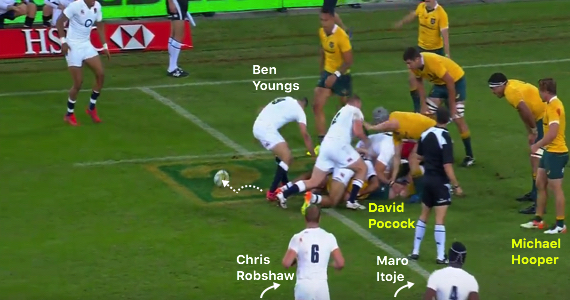
Youngs circles backwards, retrieves possession and finds Robshaw:
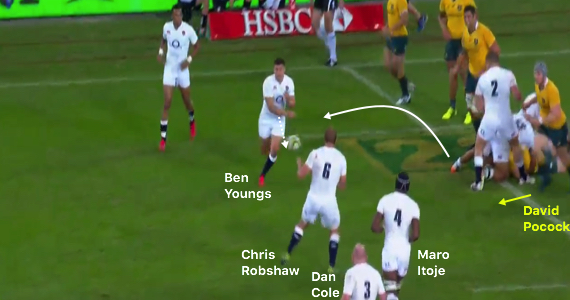
The Harlequin puts his head down and trucks forward, Itoje latching on in contact to force through the tackle of Exeter Chiefs-bound Greg Holmes:
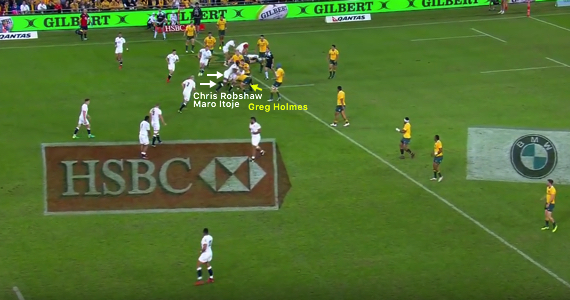
Robshaw and Itoje go to ground close to the fringe of the ruck. Holmes rolls clear and, ominously, all three members of Australia’s starting back-row are on hand to contest.
In full view of referee Romain Poite, Dylan Hartley and Dan Cole launch into the breakdown. The situation looks lost for England, but the saving grace is that carrier Robshaw is lying parallel to the touchline:
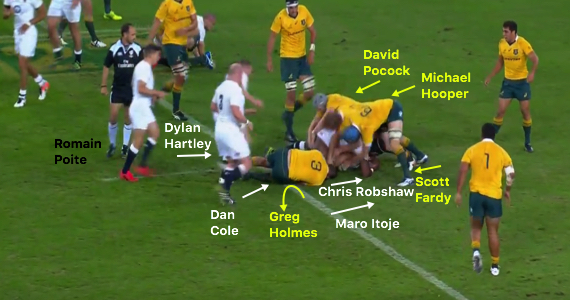
Crucially, this decreases the width of the ‘gate’ that players must use to join the ruck and, as Cole and Hartley clear out Fardy and Hooper, Poite tells Pocock that he must release:
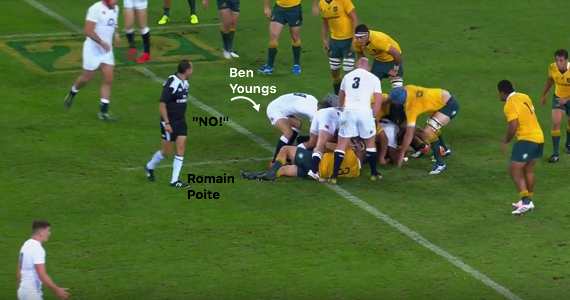
England recycle and Youngs passes to Owen Farrell, who is flanked by fellow Saracens Mako and Billy Vunipola:
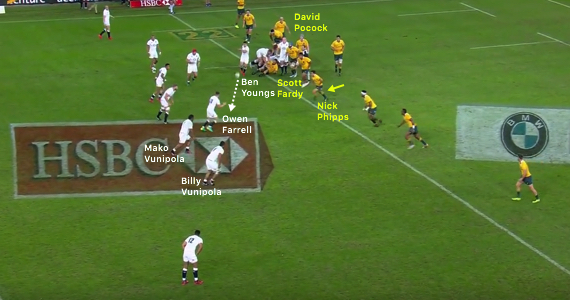
The younger sibling takes it into contact, and although Rob Horne makes a solid tackle and Nick Phipps steals in…
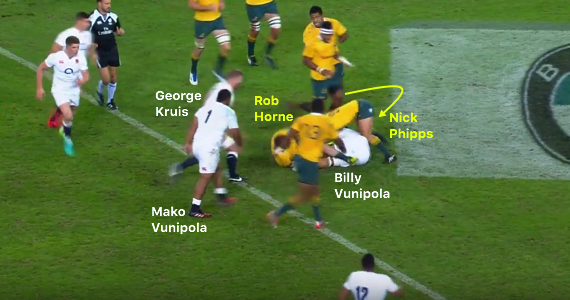
…to flick the ball backwards on to Australia’s side…
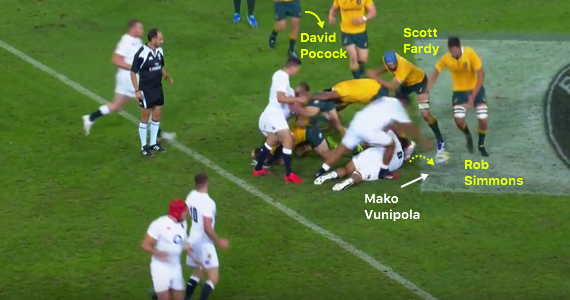
…Mako Vunipola dives through to recover the ball for England.
Poite explains the situation well – no offence has been committed, so the sides can play on. England’s loosehead prop is enveloped immediately by Rob Simmons and an unbalanced Fardy. Pocock swoops in as well.
But Hartley is following up and careers into the tackle area. Meanwhile, Billy Vunipola drags himself up and follows his captain:
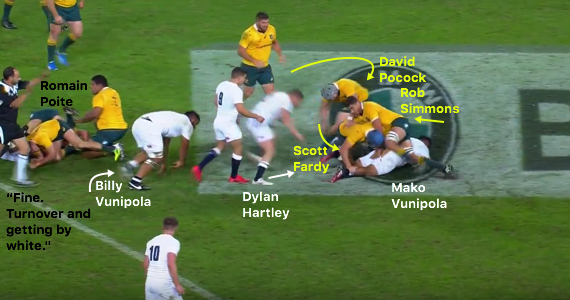
Hartley and Billy Vunipola arrive before Fardy, trapped in the ruck as indicated by the yellow dashes below, can roll clear:
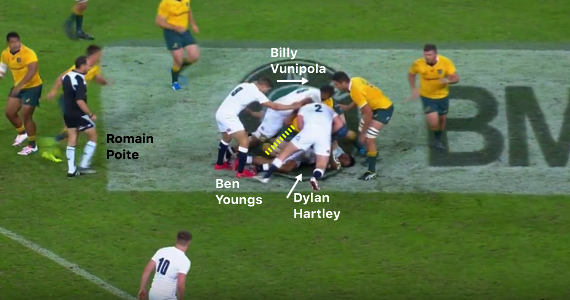
This is enough for Poite to give England a penalty, which he explains to Australia skipper Stephen Moore succinctly:

Interestingly, in a short break before Farrell lines up the ensuing kick at goal, Pocock comes forward to engage Poite in a detailed discussion about the breakdown that occurred one phase prior to the penalty.
He wants clarification that, when England latch on to one another before contact and both go to ground, there is no ruck and he can compete for the ball as the first arriving player. Poite contends that the narrow ‘gate’ meant he had come in at the side.
Note that Pocock does not get an answer to his question. This becomes important later.
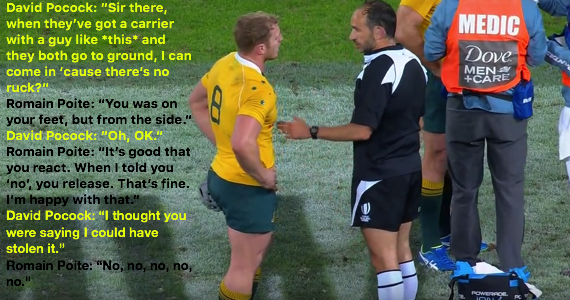
Isolation station
Of course, England did not have it all their own way. Enjoying more pressure at the start of the second quarter, still 10-3 down, scrum-half Youngs elects to bounce back against the grain and attack the blindside.
Look at Hooper being held by his boot at the ruck. That is Mako Vunipola, concealed by Luther Burrel in this screenshot. He is cynically stalling one of the Wallabies’ most destructive defenders:
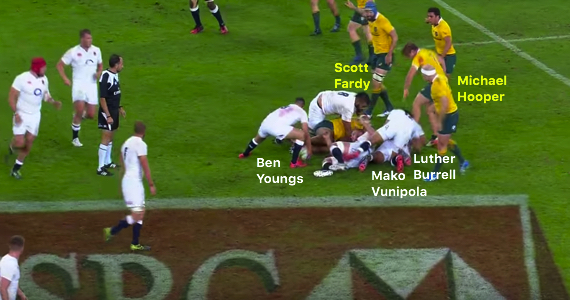
In the event, this intervention makes no difference. Youngs passes left, where Pocock and Fardy are deployed:
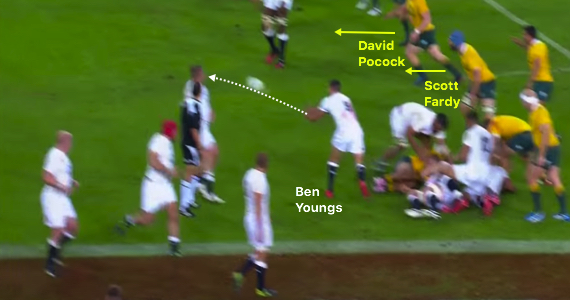
Jonathan Joseph is at first-receiver, and attempts to round Holmes, suck in Bernard Foley and free Anthony Watson on the outside. However, Watson cuts in…

…so Joseph holds on, and is stopped by Holmes and Foley. Pocock stalks…
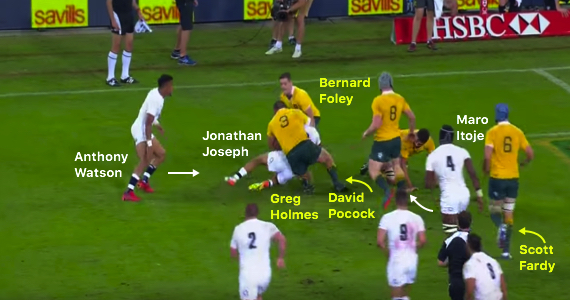
…and pounces, getting lower than Watson as Holmes rolls clear:
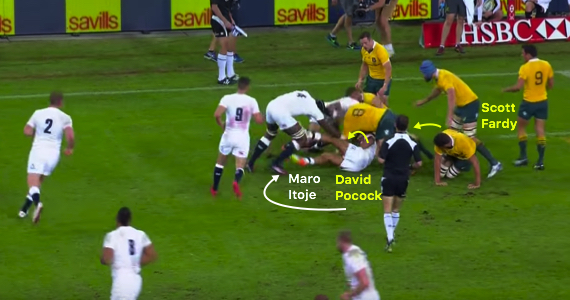
Itoje joins the ruck next and his impact does shift Pocock, but the Australia number eight is quickly back on the ball. Fardy effectively doubles Pocock’s weight by leaning in from the back foot of the breakdown. Foley appeals…

…and Poite obliges with the whistle. Youngs is not convinced, arguing that Pocock detached before clamping on again:
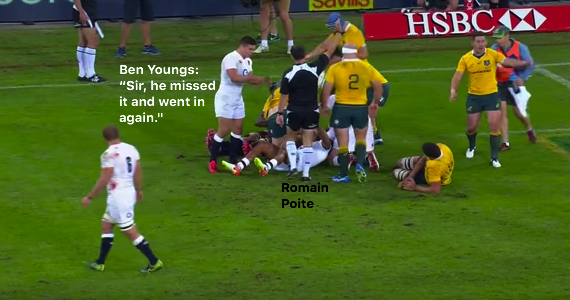
To underline just how much a referee must listen to at each stoppage, a frustrated Hooper tells Moore to ask Poite to watch out for England holding Australia back.
Poite is not clear on the point Moore is politely making at first, but eventually takes it on board:
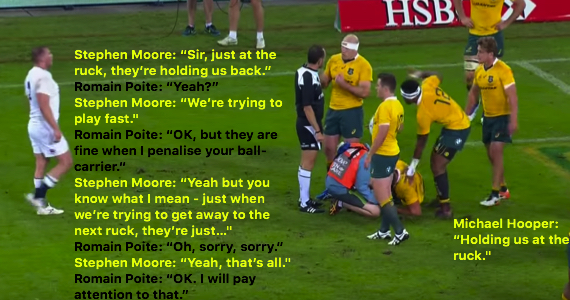
Preservation and patience
Now to the attack that reduced England’s deficit to 10-6. We join the action following a scrappy lineout. After a slow ruck, Hooper looks to line up an England carrier, shoot out of the line and cut him down – much in the same manner that Haskell does in Paul Gustard’s defensive system.
With Pocock inside him, Hooper targets Mako Vunipola…
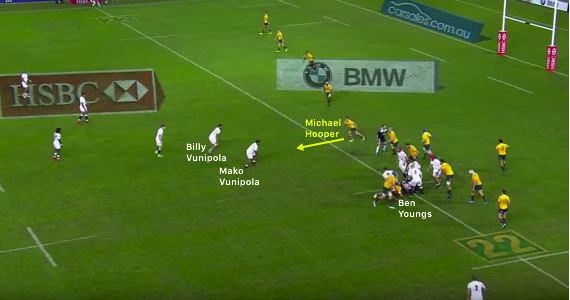
…but the speed of Youngs’ pass beats his one-man charge. Billy Vunipola is in fact the intended receiver…
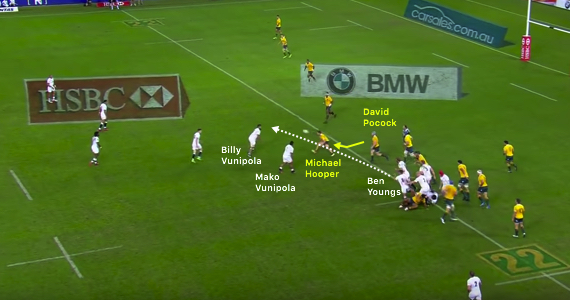
…and can carry on to Hooper’s outside shoulder:
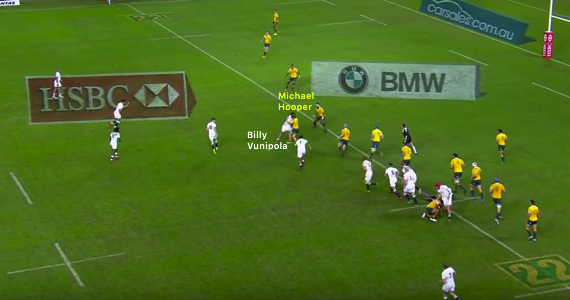
The burly 23 year-old reaches the 22, where Hooper brings him down with a judo-style hip-toss. Mako Vunipola and Robshaw approach as Pocock is poised:
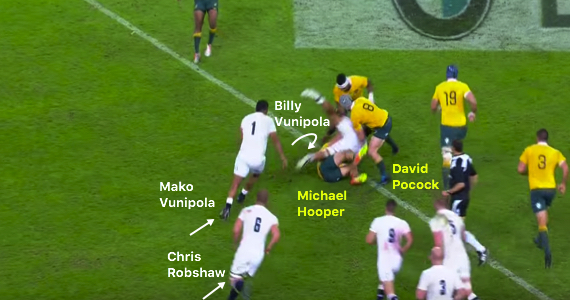
Hooper gets up and rolls towards England, trying to impede any supporting players. Pocock gets in a strong position with Samu Kerevi in the same anchor role that Fardy performed earlier. Meanwhile, Robshaw is calculated about where to clear out:
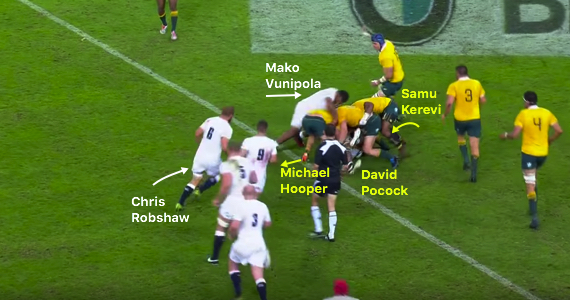
This instant encapsulates how far England’s ball retention has come since the World Cup.
Another unpromising scenario is rescued. Billy Vunipola works extremely hard to roll on the floor, making the ball a moving target and therefore more difficult for Pocock to secure.
Robshaw targets Pocock and makes good contact:
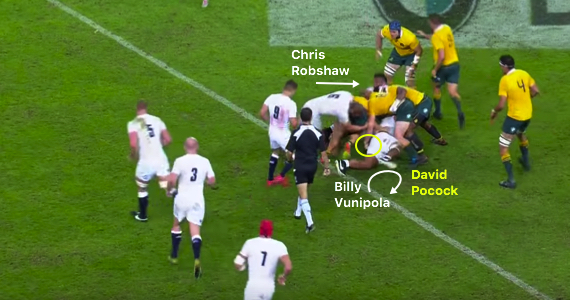
As Pocock pushes Robshaw back the other way, Poite tells the Australian to leave the ball alone:
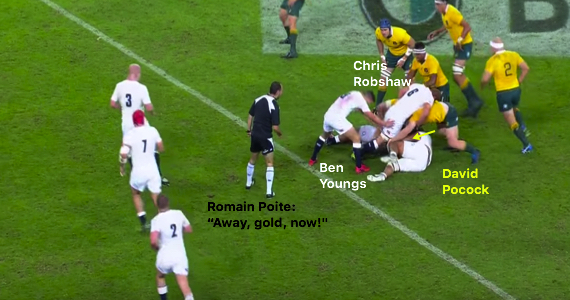
England can recycle, albeit against a well set defence:
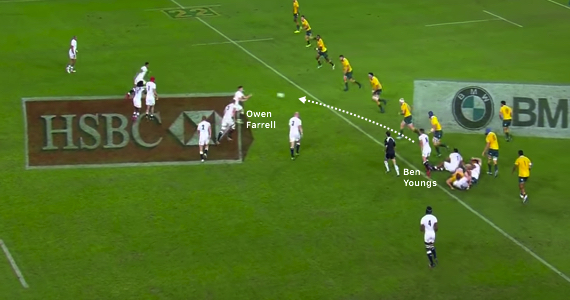
A handful of phases later, they are still slugging away. Marland Yarde comes off his wing to take a shoulder ball from Youngs.
Once more, Hooper, Fardy and Pocock are in close proximity:
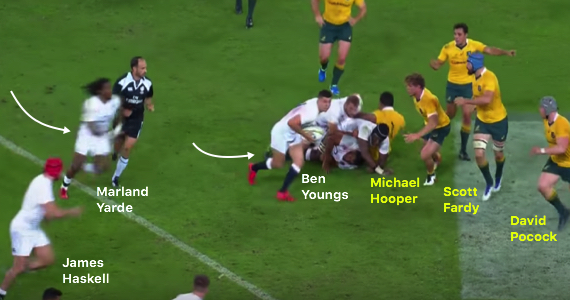
So when Yarde takes contact, aiming at Pocock – perhaps on purpose to lessen his influence as a breakdown threat – Haskell and George Kruis must be quick:
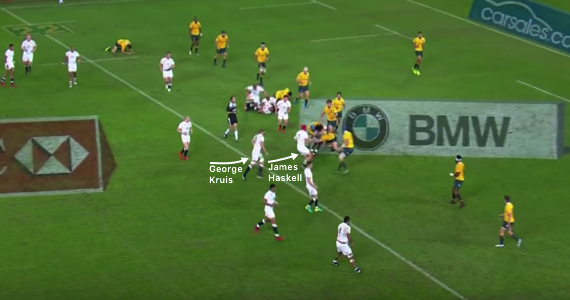
Fortunately for Jones’ team, they are. Haskell’s entry is questionable, and quite possibly from the side, but he disposes of Pocock while Kruis collides with Fardy and stays strong over the ball. The ruck is formed…

…but Fardy and Hooper roll around the side:
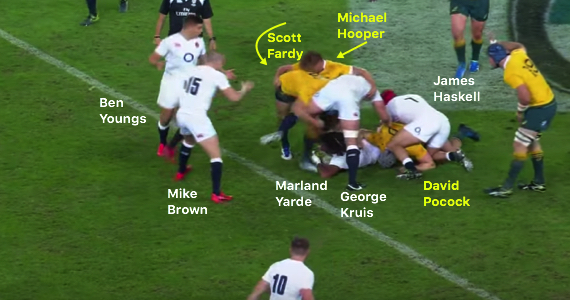
Poite’s view looks something like this…
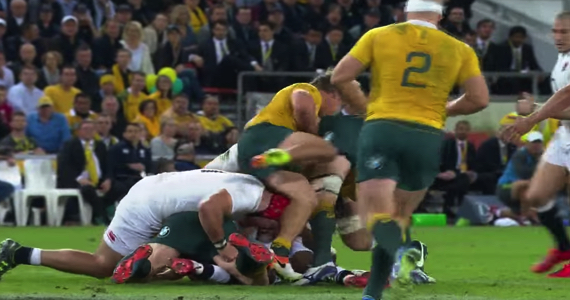
…and the Frenchman blows up as Hooper kicks the ball clear…
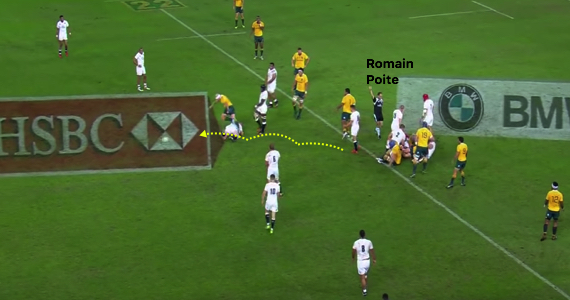
…before justifying the call to Moore:
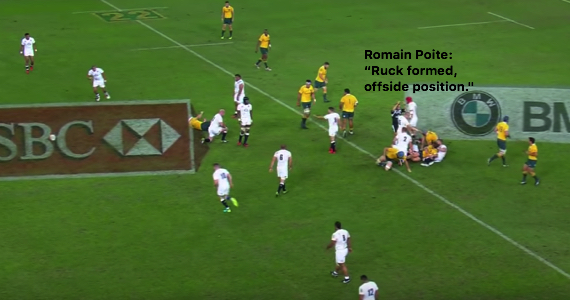
At the same time, an English voice – almost definitely that of Youngs – is heard to announce “every time” in relation to the Wallabies’ offending.
Strike three
England bring themselves to within a single point after using a lineout strike move they introduced during the recent defeat of Wales at Twickenham, a play we drew attention to in an analysis piece last week.
Billy Vunipola starts at the scrum-half position in a shortened, five-man lineout. Hartley throws to Robshaw. Circled is tighthead Holmes at the tail of the Australia lineout. This is the man England are looking to exploit:
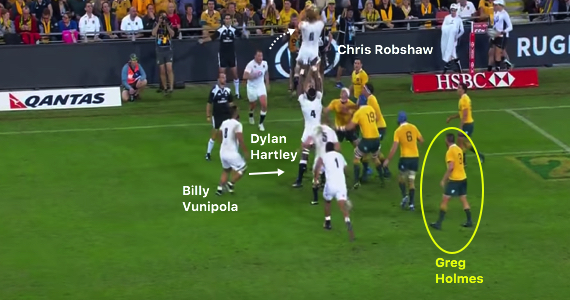
Feigning to establish a maul, Billy Vunipola tears the ball away and passes to Youngs. Holmes, sucked in, must now change direction:
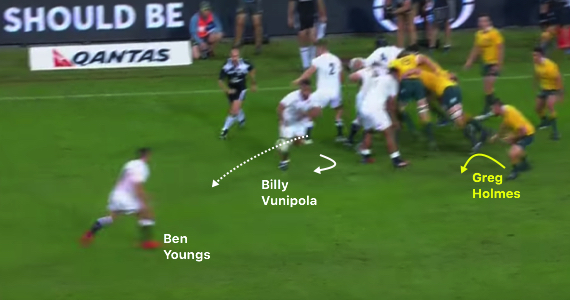
With Watson steaming up as an option for an inside pass, Youngs attacks Holmes outside shoulder and throws a dummy…
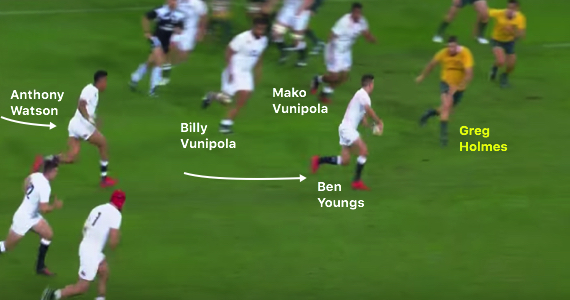
…wriggles past the tackle of Scott Sio and slips the ball to Mako Vunipola:
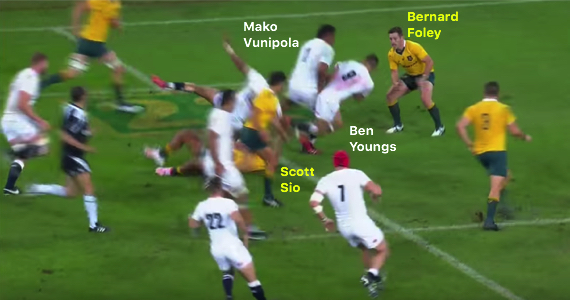
Foley and a retreating Fardy do well to slow Mako Vunipola and hold him above ground. While this gives Pocock time to arrive on the scene, it also allows Kruis – the key player in this sequence – to reach his colleague:
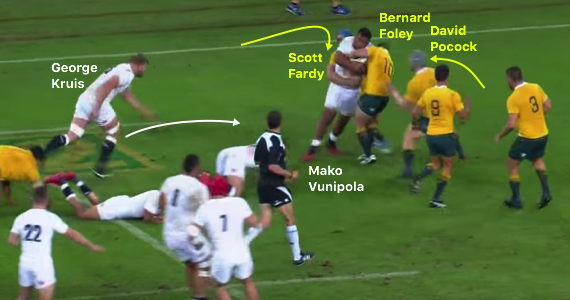
Kruis, quickly joined by the tireless Robshaw, hurls himself into the melee of bodies. This brings Scott Fardy and Mako Vunipola to ground:
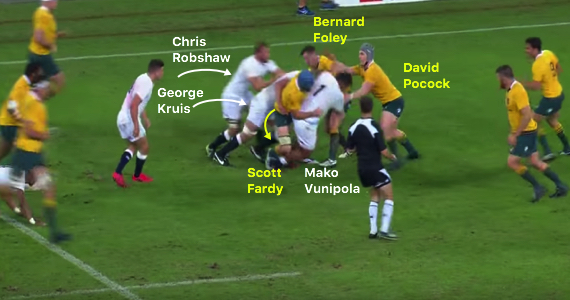
By Poite’s reckoning, the ruck is now formed. Remember, this situation – carriers being forced to ground by a conjoining teammate – is exactly what Pocock asked the official about earlier.
His question, of whether he could compete in this instance, was not answered in the affirmative (or indeed at all). So when Pocock does delve for the ball, Poite tells him to leave it…
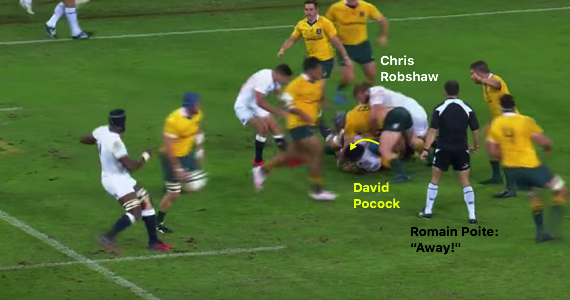
…and, with Youngs screaming his view, the referee makes up his mind:
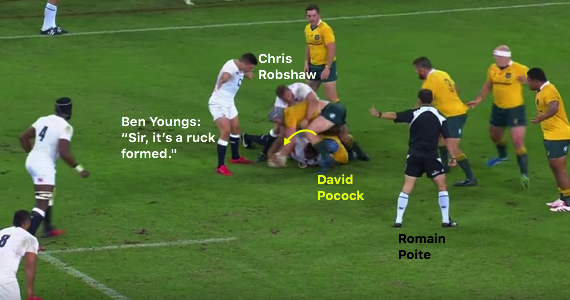
Now, this will not sit well with some, but Youngs’ subsequent reminder to Poite – stressing the fact that Australia have now infringed at three defensive breakdowns in their own 22 – is a canny piece of game management:
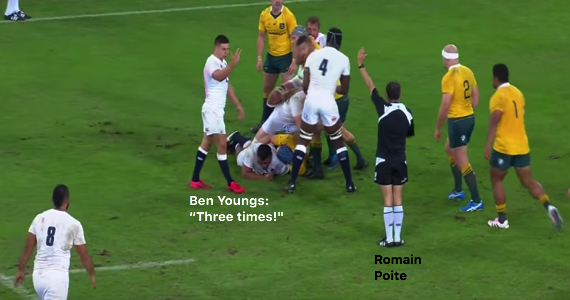
After dismissing the protestations of a bemused Pocock, who starts to ask if a ruck was actually formed…
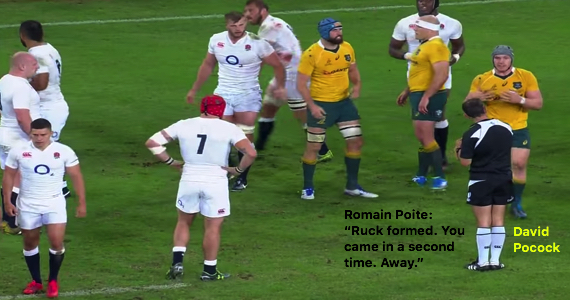
…Poite beckons Moore and runs through the catalogue of recent offences, inferring that another will glean a yellow card:
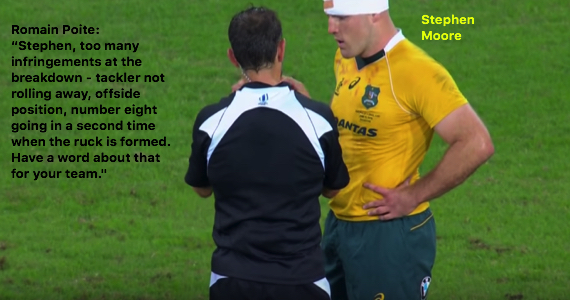
England coerced these lapses of discipline from Australia. At this point, the penalty count stood at eight to one in the visitors’ favour. From the next restart, Joseph scored England’s first try for a 16-10 lead.
But, just before half-time, Hooper offered a reminder of how his explosiveness can alter the course of any breakdown skirmish.
Beating the breakdown
Ahead 16-13 because of a Foley penalty, England are going through their punchy phase-play with Billy Vunipola coming around the corner:
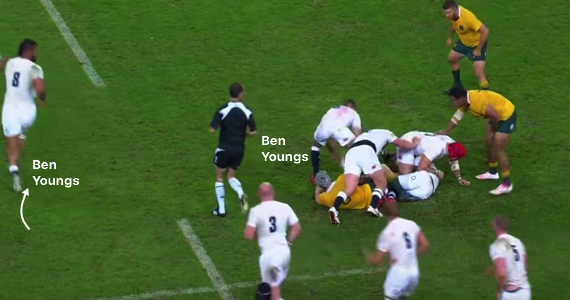
Youngs feeds him…

…and he pirouettes past Holmes, although Hooper holds on to complete the tackle:
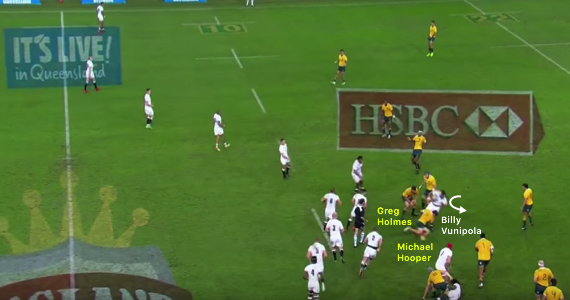
The Waratahs talisman is straight back on to his feet, before a player from either side has formed the ruck:
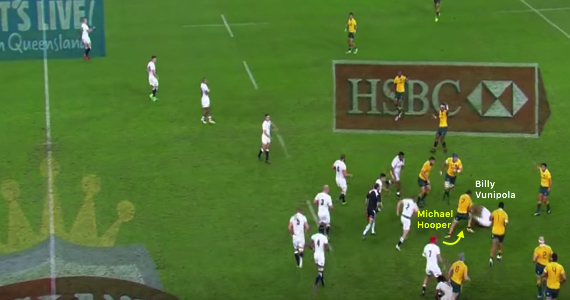
Here, it is worth looking at the official definition of a ruck…

…and the law that stipulates that a tackler can approach the ball if they are back on their feet before a ruck has formed:

Hooper knows these laws and has the spatial awareness to realise that a steal is on the cards. As Hartley tears past Hooper, desperate to clear out a gold jersey, the Wallaby number seven looks for the ball:
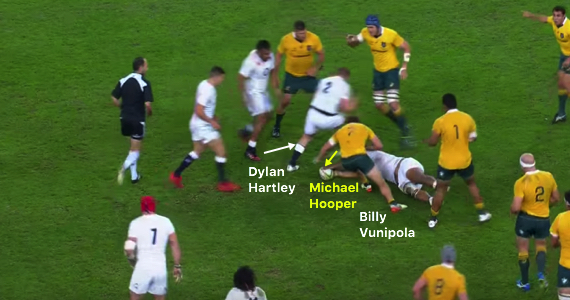
Meanwhile, Hartley hits James Horwill. Holmes arcs around the back foot and Mako Vunipola arrives:
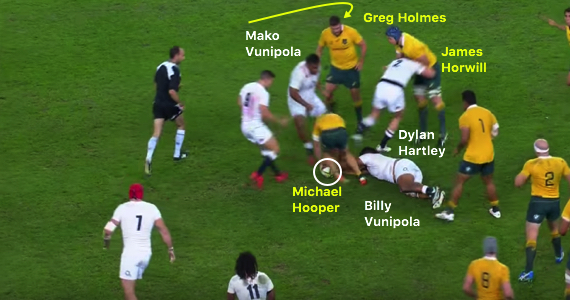
In the event, Hooper misses the ball. However, the effort clearly distracts England. Both Youngs and Haskell expostulate with Poite and though Mako Vunipola reacts well to pick it up:
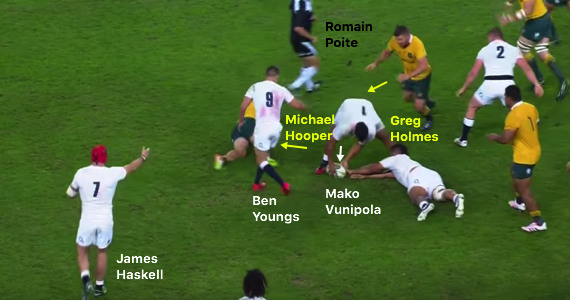
An opportunistic tackle from Holmes forces a knock-on:
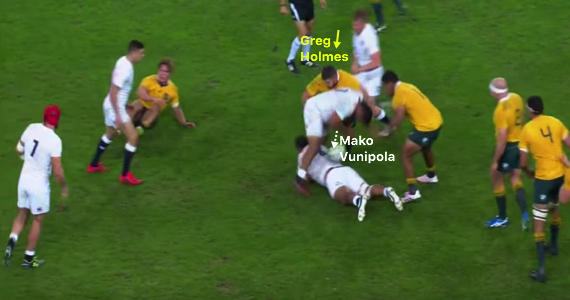
With the forwards gathering for the consequent scrum, Poite delineates why Hooper was legal:
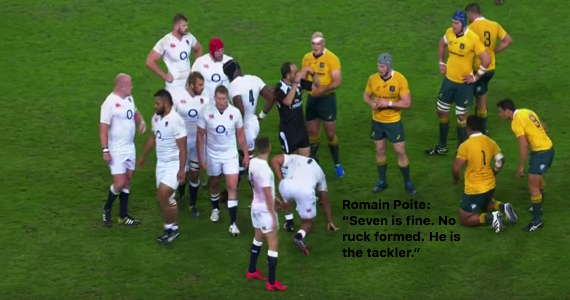
Three amigos
As hinted earlier, the make-up of England’s back-row for last Saturday was doubted by many. Certainly, it was inferior in terms of raw pace and pilfering prowess. But Robshaw, Haskell and Billy Vunipola have become a mightily effective, complementary unit.
The breakdown aptitude of Itoje, Cole and Mako Vunipola bring balance, and England’s restraint – identifying a lost ruck and leaving it alone so as not to concede a penalty – has improved out of sight in the wake of the World Cup.
This trait was pivotal at the weekend and one passage in particular summed up how the qualities of Robshaw, Haskell and Billy Vunipola combine. We start as Australia scrum-half Phipps looks towards the blindside to see brawny wing Dane Haylett-Petty facing two half-backs. Robshaw is the openside guard…
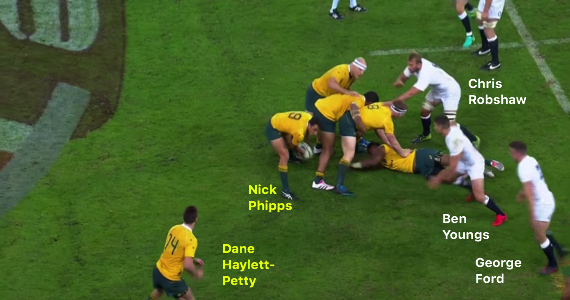
…but swings around the corner…
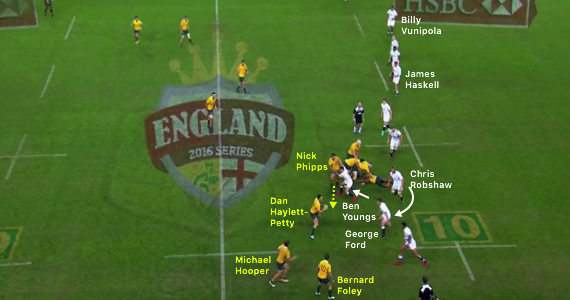
…and helps wrap up Haylett-Petty, holding the debutant above the ground:
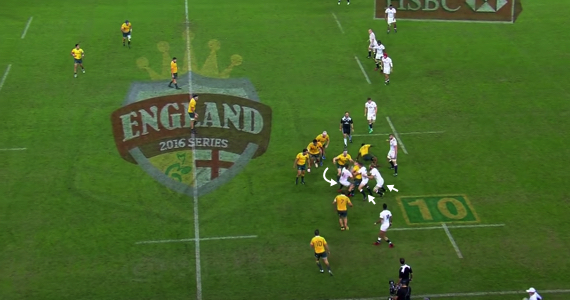
England’s former captain, set for a 50th cap in Melbourne, compels Poite to call a maul as four supporting Wallabies pile in:
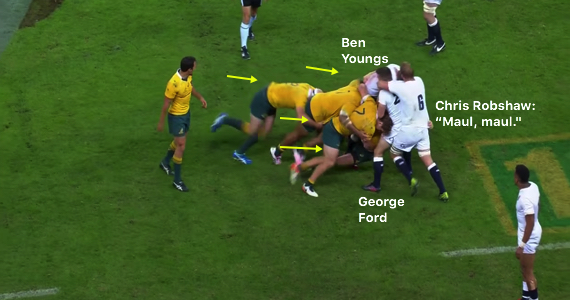
Though England do not succeed in forcing a maul turnover, they do sap the speed of this phase. When Phipps passes left, carrier Rory Arnold is faced with a well-organised, proactive line.
England’s back-rowers are all circled…
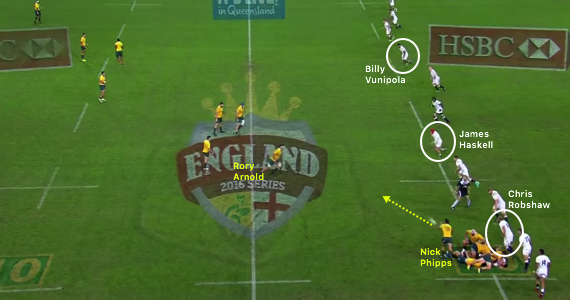
…and Haskell, as he has licence to do, shoots up to cut down Arnold:
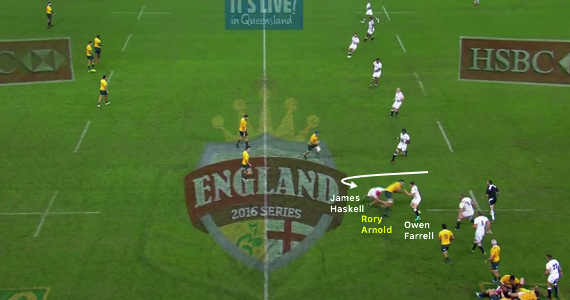
This provides Robshaw with a chance to jackal amid the attentions of Harlequins clubmate Horwill:
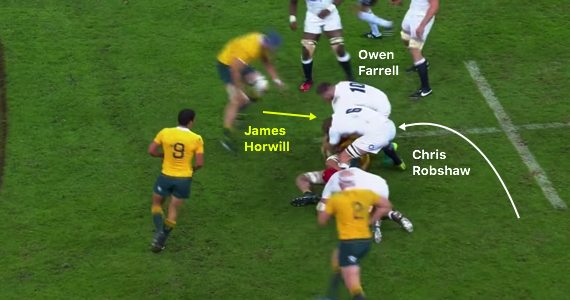
Horwill’s clear serves its purpose and removes Robshaw, who resists temptation to dive back into the ruck and simply backs away…
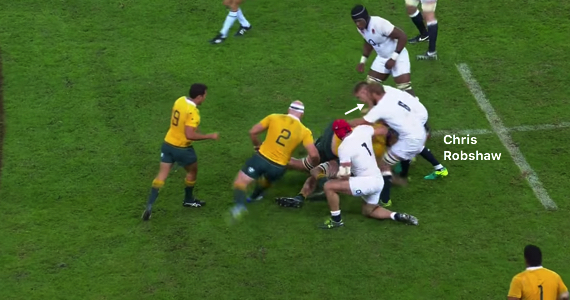
…joining a circled Billy Vunipola in the defensive line as Phipps finds Foley:

Foley takes the ball to the gain-line and bypasses an unconvincing decoy line from Holmes to hit Christian Lealiifano out the back. Vunipola presses…

…creeping into the eyeline of Lealiifano as the Brumbies playmaker tries to locate Israel Folau:
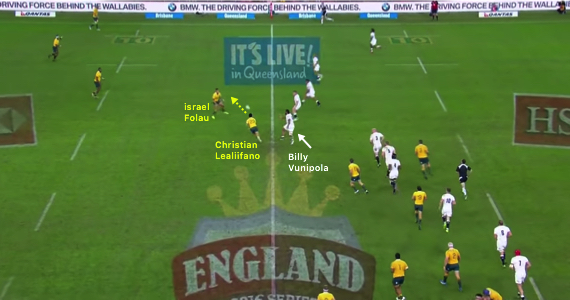
Billy Vunipola rushes up at this point and the ball goes to deck:
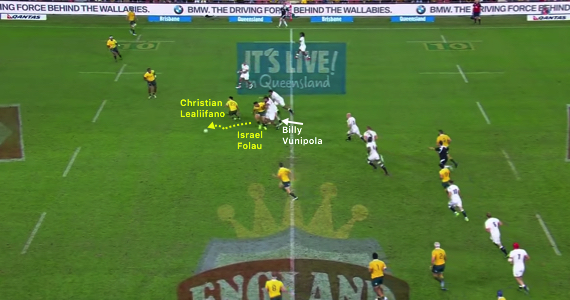
Though Lealiifano recovers, Hartley dives at his feet…

…and trips him into the lap of a welcoming party:
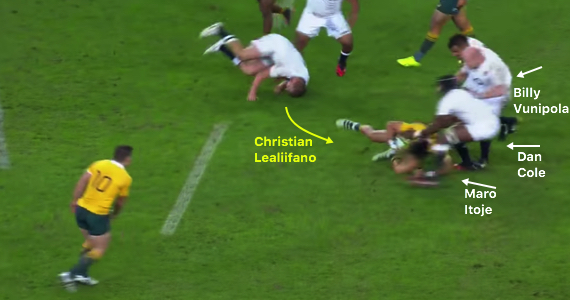
Now, England could easily get overexcited here. Test matches do not offer better chances for a turnover. However, they remain composed.
Itoje rolls past the ball and out of the way, Billy Vunipola goes through the gate and latches on to the ball, with Cole sneakily supporting his number eight from the side:
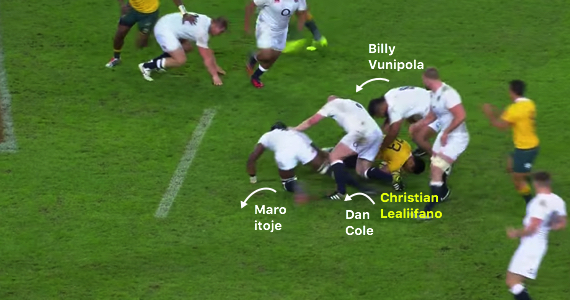
When Australia support does arrive from Tevita Kuridrani, it cannot budge Billy Vunipola, who receives additional fortification from Mako. Hartley is in Poite’s ear…
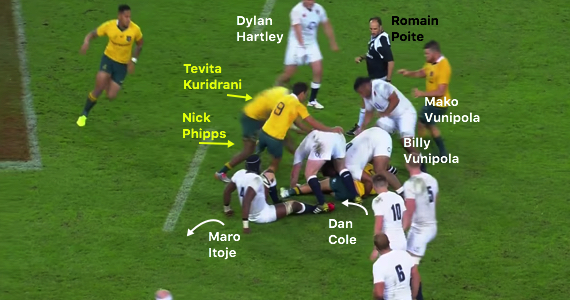
…and the penalty comes:

Moore queries the technique of Billy Vunipola, but an irritated Poite shuts the Australia hooker down:
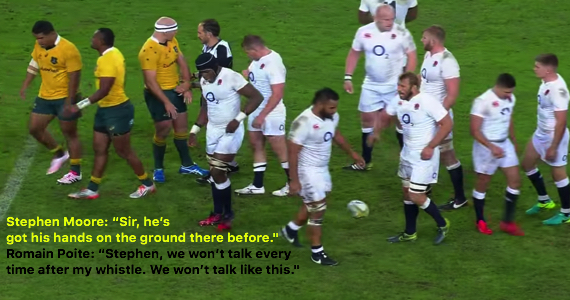
Farrell hit the post, but Robshaw’s follow-up forced the Wallabies to rush their clearance. From the next lineout, Haskell burst away and Yarde scored in the corner. At 26-10 to the good, England were in dreamland. When Australia inevitably fought back, the breakdown was fundamental to survival.
Racing the ruck
Around the hour mark, England needed to repel wave after wave of gold. It took an exceptional piece of nous from Haskell to quell the pressure. Australia are around 10 metres out here, with Haskell curving round to assume body guard responsibilities:
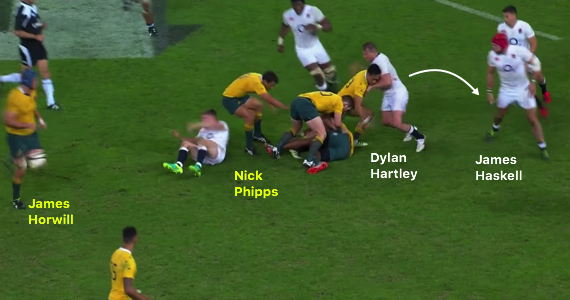
Phipps snipes before playing in replacement Dean Mumm. Haskell has slightly over-chased…
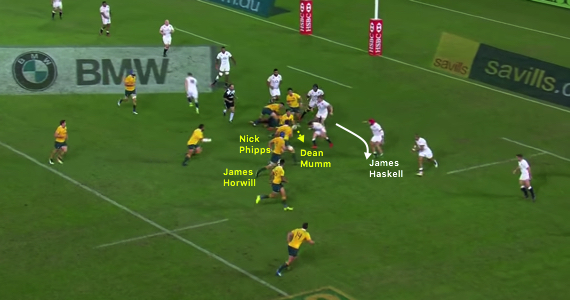
…but doubles back to fell Mumm:
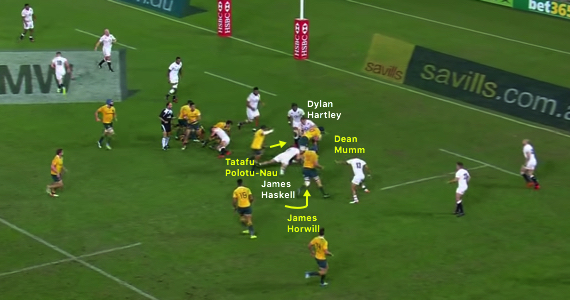
Now, as Haskell bounces up and has a sniff at the ball, Wallabies replacement Tatafu Polotu-Nau and Hartley are the critical protagonists.
Polotu-Nau first makes contact with Hartley well past the ball. Therefore, certainly in the eyes of Poite, there is no ruck:
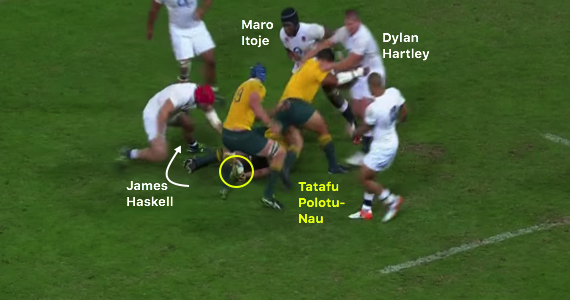
Haskell, as the tackler, is entitled to pounce for the the ball…
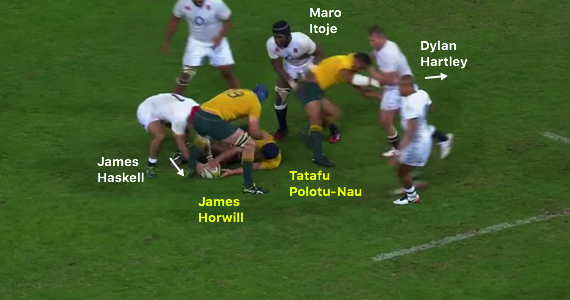
…and he does, circling away. By this point, Itoje and Horwill are in contact over the ball. The ruck is formed now, but Haskell is already away:
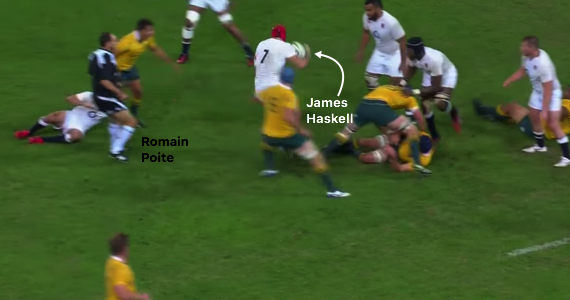
As he was all game, Poite is open with his decision-making process. Just as he did with Hooper, he proclaims Haskell as the tackler and allows play to go on:
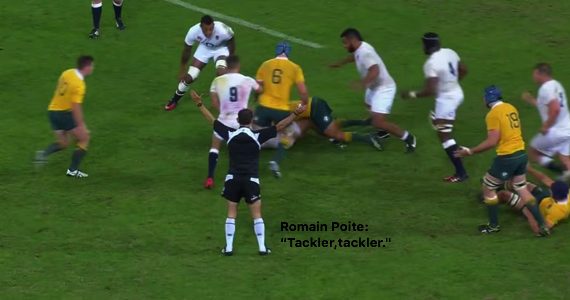
Pocock’s fractured eye-socket means a new starter will join the Wallabies back-row for the second Test. Michael Cheika is mulling over a change in dynamic, loading another ball-carrier.
More significantly, a southern hemisphere referee takes charge in South Africa’s Craig Joubert. For England to seal the series, they need to adapt and be even more accurate than they were in Brisbane. Another epic is in store.






